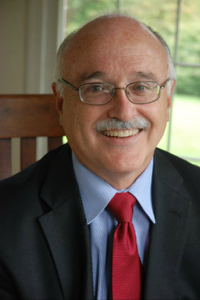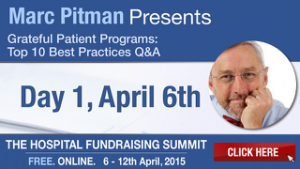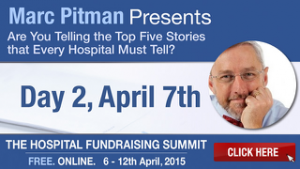Marc A. Pitman's Blog, page 33
April 6, 2015
[Guest Post] Improve Your Nonprofit’s Fundraising with Prospect Research
I'm pleased to welcome Bill Tedesco, founder and CEO of DonorSearch, my favorite prospect research tool. Prospect research is so vitally important to successful nonprofit fundraising. But so misunderstood by nonprofit leaders. A veteran of prospect research, Bill shows you how researching your donors and prospects can move your fundraising forward. You can learn more about Bill at DonorSearch.net. And DonorSearch can be reached on Twitter @DonorSearch.
Improve Your Nonprofit's Fundraising with Prospect Research

by Bill Tedesco
Fundraising is like an I Spy book. You’ve got pages and pages of donors, but your nonprofit is only looking for certain people. Those people are major gift prospects who can contribute large sums that allow your organization to more effectively pursue its mission. You can find major donors faster with prospect research.
Great I Spy players find what they’re looking for fast, so they can move on to the next page. Great fundraising campaigns find major gift donors fast, so they can land the next significant donation.
How can your organization find major gift donors effectively?
Prospect research returns comprehensive philanthropic and wealth data that helps you pinpoint major gift donors in less time, so you can dedicate more time and resources to other phases of the fundraising process.
What is prospect research?
How much money does a prospect have? Does he own a boat? Is she a CEO?
Fundraisers, development teams, and nonprofits want to learn as much as possible about their donors, and prospect research provides:
Personal backgrounds
Past giving histories
Wealth indicators
Philanthropic motivations
You won’t learn every quirky behavior, such as why a donor prefers relish to mustard, but you’ll be able to evaluate a prospect’s capacity to give and his affinity for your organization, which is what you need to spot the major gift prospects among the masses.
What specific information does prospect research provide?
You won’t find out if a donor prefers plaid to stripes, but you will receive lots of relevant information, such as:
Previous donations to your nonprofit – Like a grandmother who can’t stop baking you cookies, it’s always nice to have reliable people who consistently want to give more, even if they only give small amounts. Planned donations, which can be quite large, tend to come from consistent, modest donors.
Donations to other nonprofits – Your nonprofit is unique, but similar in mission, geography, and fundraising needs to other organizations. Donors to similar nonprofits can be good matches as major donors for your organization. In fact, donors who have given $100,000 or more are 32 times more likely than the average person to give to another nonprofit, and lesser donations also predict higher levels of donor affinity to give elsewhere.
Political giving – Giving to campaigns and other political programs is an indicator that donors want to give to causes they care about, which translates to charitable giving. Donors who give more than $2,500 to political campaigns are 14 times more likely than the average person to donate to a nonprofit.
Nonprofit involvement – People who work for or volunteer for nonprofits understand the need for donations and are more inclined to give.
Real estate ownership – Donors who own $2+ million in real estate are 17 times more likely than the average person to make a charitable donation.
Business affiliations – Wealthy donors tend to have wealthy friends who might also be good fits for your organization. Also, employer information reveals if a donor works for a company that matches charitable donations. Corporate giving can double employee donations, and it is easy money that your nonprofit should seek at every opportunity.
Personal information – Avoid awkward asks and wrong numbers by letting prospect research deliver up-to-date phone numbers, addresses, spousal information, and other basic contact information.
The more prospect data you can acquire the better, as this information allows you to personalize the entire fundraising process for each major gift prospect.
How can a nonprofit conduct prospect research?
Prospect research is one of many strategies to find new donors, and there are several ways to do it. No matter how you conduct your prospect research, it’s a full-time job for someone:
Prospect screening companies – Their vast arrays of tools scour a plethora of databases to provide comprehensive philanthropic and wealth data in a comprehensible, shareable format. Also known as prospect research companies, these companies allow your organization to place the effort of unearthing donor information on a reliable, outside source, saving your staff time and resources for other necessary tasks.
Prospect research consultants – These guys (and gals) tend to be former prospect researchers who want to save your nonprofit valuable time and resources by discovering your best prospects, training your staff on prospect research, and developing better prospect strategies. You’ll want to find someone who fits your organization’s culture at a fair price.
Do-it-yourself (DIY) – Your organization may consider hiring a full-time prospect researcher. This can be a significant investment of time and resources, so be cognizant of what your organization can handle.
Pick the strategy that works for your organization and your budget. If you go with a prospect research company then make sure to find out what information each company provides and at what cost.
Why do nonprofits need prospect research?
When a basketball team that struggles to defend the three point arc acquires an elite interior defender, the rest of the team is free to better guard the perimeter, which improves the team’s defense. Likewise, prospect research plays a pivotal role that allows your fundraising team to focus on other priorities to maximize your efforts.
A major resource that prospect research saves is time. To exemplify this benefit, let’s say you have no current major gift prospects:
Without prospect research – You’re on offense, your team shoots a wide open three-pointer to win the game, and you air ball. If you’re not unearthing vital prospect information, then you’re missing the chance to capitalize on the major donors who are statistically the most likely to give. You’re also losing out on identifying new major gift prospects in your database, which means that you’re not even getting to take the shots that, if made, could put you over the top.
With prospect research – You can receive donor data from a company or consultant, conduct research in-house, or employ multiple strategies at once in order to identify major gift prospects. By sifting through databases and various records, you uncover the information that allows you to both approach the prospects who are most worth your valuable resources and to individualize ask strategies. It’s like stepping to the free throw line and hitting both shots for the win.
Increasing major donations might be as simple as implementing a dedicated prospect research strategy today. You should notice an increase in revenue, and, when performed alongside other top fundraising strategies, prospect research can improve your event planning, ask strategies, and other efforts. Not only will you raise more money, but you just might improve your entire fundraising operation.
For more, check out Bill's training in The Nonprofit Academy, "Prospect Research for a Small Shop."
The post [Guest Post] Improve Your Nonprofit’s Fundraising with Prospect Research appeared first on FundraisingCoach.com.





March 30, 2015
Fundraising Kick: Fundraising is NOT from a diminishing pie
Each week, I send out a coaching email to nonprofit CEOs, Executive Directors, and leaders. These Fundraising Kicks are quick emails designed to help them get out from behind their desk and in front of donors. Often they have scripts or task lists. Sometimes they contain attitude adjustment reminders.
Here's one I wrote for today. It will definitely help in your fundraising this week.
 Good morning, Kickers!
Good morning, Kickers!
I’m relieved that last week’s Kick was helpful for so many of you. Thanks for the feedback. And good for those of you making the necessary steps to get out of bad relationships.
This week, I wanted to write to you about pie. Really. Lately more and more people have been talking to me in terms of scarcity, as though their fundraising was trying to get a piece of a limited pie that was running out.
Money is a weird thing. It’s usually only as limited as your self-limiting beliefs make it. Some people see scarcity; others see abundance. And you usually get what you see.
Donors are weird too. Once they get excited about a project, they sometimes give more than we expect. Others, like our board members, surprise us by giving to projects other than ours. It’s not that they aren’t giving, they’re just deciding not to give to us. That can feel incredibly disheartening. But that usually means we haven’t been connecting our work to their passion.
Your mission this week
Fundraising has never been about a limited pie. It’s much more akin to the old “Stone Soup” fable. As we all put in what we have, an incredibly new creation is made. And the giving creates a virtuous loop inspiring new people to share too.
As you make the 5-10 calls this week, be aware of your fear of scarcity. When you feel it gripping you as you dial, remind yourself there is not just one pie of money but there are lots of pies! Part of your calling the major gift prospects is to be open to the surprise of discovering new pies.
It could be expanding your “fundraising” vision to a “resourcing” vision. What resources do you need to accomplish your mission? Donors may be able to give things that offset significant budgeted expenses far more easily than they are able to give cash. But it could simply be finding a way to ask the donor in line with their values.
So make the calls, or even better get out from behind your desk and make the visits. Your mission deserves funding. And there is more than enough out there to fund it. You just need to unearth those resources!
Have a great week,
Marc
Want to get these fundraising coaching emails yourself? Sign up at http://fundraisingcoach.com/fundraisingkick/.
The post Fundraising Kick: Fundraising is NOT from a diminishing pie appeared first on FundraisingCoach.com.





March 23, 2015
71 sessions to help your hospital fundraising – for free!


If you raise money for a hospital, or are thinking of moving into that career, you need to register for the The Hospital Fundraising Summit. It's coming April 6 - 12 and gathering 48 of us, giving over 70 sessions!
The schedule for The Hospital Fundraising Summit
I've just heard that the schedule for The Hospital Fundraising Summit is now final. Each session is available for viewing for 24 hours only, starting at 08:00 am Eastern Time.
Here is the schedule, arranged by track. (Mine sessions are in the "Grateful Patients" and "Donor Communications" sections.
HOSPITAL ANNUAL GIVING
Bloom, Carl: 25 Proven Ways to Generate Individual Gifts for Your Hospital with Direct Response Fundraising
Bloom, Carl: How to Build a Direct Response Fundraising Program that Delivers High Value, Long-Term Return on Investment
Checkoway, Nelson: Pushing the Envelope: Thinking Unconventionally for Direct Mail Fundraising Success
Hoppe, Peter: Mid-Level Giving: Paving the Way to Major and Planned Gifts for Your Hospital
Hoppe, Peter: 20 Things You Should Know Before Planning Your Next Hospital Direct Response Campaign
Kravinchuk , David: The 5-cent Fundraising Phenomenon
McKinnon, Harvey: Run a Successful Monthly Giving Program for Your Hospital
Olsen, Andrew: Turn Your Hospital Newsletter Into a Moneymaker
Wester, Lynne: Improve First Time Donor Retention Rates for Your Hospital
HOSPITAL BOARD FUNDRAISING
Axelrad, Claire: Overcome Your Board’s Fear of Fundraising, Once and for All
Perry, Gail: How to get your hospital foundation board members to open doors to major gifts
Weisman, Carol: Getting your Board Productively Involved in Fundraising
GRATEFUL PATIENTS
Antarakis, Dominique: How to Effectively Gather and Share Patient Stories for Hospital Fundraising
Carley, Catherine: Direct Mail Patient Acquisition and Renewal Best Practices
Blease, Kimberley and Michelle Carter: The Changing Face of Donor Acquisition for Hospitals
Pitman, Marc: Grateful Patient Programs: Top 10 Best Practices
CAPITAL & ENDOWMENT CAMPAIGNS
Egles, Sue: Shake Hands with Your Future: Introducing the Revolutionary New Way to Conduct Campaign Feasibility Studies
Lysakowski, Linda: Capital Campaign Tips for Small Hospitals
Macnab, Sandy: Seven Things You Must Learn from Your Next Campaign Feasibility Study
Wester, Lynne: The Naming Game: Creative Ways to Permanently Recognize Your Hospital Donors
Wineinger, Cris: How to Launch a Hospital Capital Campaign from Zero: A Case Study (Q&A
Wineinger, Cris: How Your Hospital Can Run a Successful Endowment Campaign (Q&A)
CORPORATE PHILANTHROPY & SPONSORSHIP
Clemence, Abby: Eight Easy Steps to Turn Cold Calls into Corporate Partners
Lysakowski, Linda: Raise More Money from Your Business Community
DONOR COMMUNICATIONS
Ahern, Tom: Loverizing: The Lucrative Difference a Few Well-Chosen Words Will Make in Your Hospital Donor Communications
Chamberlin, Frank: Your writing toolbox for more impactful fundraising
Goossen, Gayle: Ten Tips for Finding and Telling Stories that Inspire Your Hospital Donors to Give
Grow, Pamela: The Power of Thank You
Jacobwith, Lori: Finding and Telling Powerful Stories that Raise Lots of Money for Your Hospital
Kravinchuk , David: Thanks a Million: How to Boost Donor Loyalty and Revenue with Simple Stewardship Strategies
McKinnon, Harvey: 11 Questions Every Hospital Donor Asks
Pitman, Marc: Are You Telling the Top Five Stories that Every Hospital Must Tell?
HUMAN RESOURCES
O'Byrne, Maeve: Top Tips for Hiring and Retaining Hospital Foundation Fundraising Staff
Sudol, Ted: Solo Success: How to Survive & Thrive When You’re the Only Fundraiser at Your Hospital
Twiford, Lise: Managing and Fostering Your Hospital Development Team
INTEGRATED FUNDRAISING
Blease, Kimberley and Peter Seybold: How Digital Integration is Driving Success in Healthcare Fundraising
Garnett, Ryan: Integrated Fundraising on a Small Budget: A Primer for Hospitals
Olsen, Andrew: Build an Integrated Fundraising Strategy for Your Hospital
MAJOR GIFTS
Angeletti, Jay: Metrics-Driven Major Gifts: Creating the Perfect Balance Between Metrics and Customized, Creative Principal Gift Relationships (Q&A)
Axelrad, Claire: Anatomy of a Major Gifts Ask: The Art and the Heart
Carlson, Diane: Major Gifts for Your Hospital: How to Do the Ask
Carlson, Diane: Prospect Research: What You Need to Know Before you Solicit a Major Gift Prospect
Heim, Marcy: Creating a RAP! (Relationship Action Plan)
Heim, Marcy: Creating Life-Long Major Giving Relationships – A Team Sport!
Perry, Gail: Where to find more major donors for your hospital foundation
Raff, Larry: Determining How Much to Ask for in a Major Gift
Raff, Larry: Building Rapport is the Key to Major Gift Success
Smith, Jerry: Securing Major Gifts for Your Hospital Foundation: Expect to Win
Smith, Jerry: How to Overcome the 10 Familiar Faults Found in Hospital Fundraisers
Stroman, Kent: Asking about Asking: Mastering the Art of Conversational Fundraising
Twiford, Lise: Measuring and Managing Your Hospital's Major Gift Fundraising Metrics
HOSPITAL MARKETING
Goossen, Gayle: Engage Your Hospital Donors (and Increase their Loyalty) with Content Marketing Q&A
ONLINE FUNDRAISING & SOCIAL MEDIA
Miller, Carrie: Online Fundraising: Getting Your Hospital on the Road to Success
Semple, Maria: How to Use Social Media to Acquire Supporters and Raise Funds
PHYSICIAN FUNDRAISING
Angeletti, Jay: Physician Partners: Informal and Formal Engagement Strategies/Tactics that Transcend Today's Challenging Landscape
Holt, Susan: Bold Plans. Bold Asking: Coaching Your Board and Physicians in Capital Campaigns for Bold Results
Weisman, Carol: Help Your Physicians Become Productively Involved in Fundraising (Q&A)
PLANNED GIVING
Bendeddouche, Amel: How to Raise Bequests for Your Hospital with Direct Mail
Eustace, Leah: Create Effective, Engaging and Inspirational Bequest Marketing for Your Hospital
James, Russell: The Words that Work in Major and Planned Gifts
James, Russell: Inside the Mind of the Bequest Donor
Macnab, Sandy: How to Find Planned Giving Prospects for Your Hospital
Mikaelian, Viken: Four Easy Planned Gifts Your Hospital Can Receive
Sagrestano, Brian: Dying to Donate to Your Hospital? Conducting Planned Giving when Your Donor is Making End-of-Life Decisions
Sagrestano, Brian: How to Engage Professional Advisors to Find Donors for Your Hospital
SPECIAL EVENTS
Truhlar, Sherry: Five Steps to a Better Silent Auction: Easy Changes for Higher Revenue
Truhlar, Sherry: Double Your Hospital Foundation Auction Revenue in 15 Minutes with a "Fund a Need"
HOSPITAL FUNDRAISING TRENDS
Butler, Stephen and Michael Johnston: Building the Fundraising Hospital of the Future
Holt, Susan: Are We there Yet? Where is Your Culture of Philanthropy Today?
Raymond, Susan: The Imperative of New Approaches to Fundraising Strategy for Hospitals – Q & A
Raymond, Susan: The Ascendency of Women
Sign up for free
Phew. That's quite a list! And you get it free. You can read all the details and register at http://summit.hospitalfundraisingtoday.com/.
If you miss any of the presentations, you can purchase all the recordings at: http://summit.hospitalfundraisingtoday.com/buy/. Then you'll be able to go over them again and again. And be able to share them with your team.
I hope you'll join us!
The post 71 sessions to help your hospital fundraising – for free! appeared first on FundraisingCoach.com.





March 16, 2015
[Guest Post] 4 Fundraising Questions for Your Board Chair
I like John Fulwider. His energy, optimism, and experience make a powerful force for helping nonprofits. I suppose this is in part because of his expertise with Gallup's StrengthsFinder. He knows every organization and every leader has strengths and he's skilled at building on them. His new book Better Together: How Top Nonprofit CEOs and Board Chairs Get Happy, Fall in Love, and Change Their World is a great example of that! In this post, I've asked him to share some ideas from his research for the book. You can find out more about John at his site www.JohnFulwider.com and you can reach him on Twitter @johnmfulwider.
4 Fundraising Questions for Your Board Chair
John's at his wit's end with his board. He can't get them engaged in fundraising strategy or tactics. Every board meeting he reports the revenue numbers and the latest sexy fundraising ideas he's come across. Why won't they get engaged? Why won't they think strategically?
Jami's overflowing with gratitude for her board. She pinches herself at least once per meeting as board members dive deep into strategic thinking about funding her organization's future. She hears enthusiastic "Yes, and" statements so much she's forgotten the bad old "No, because" days. Her board members generate good ideas and gladly take personal action.
Jami engaged her board chair first as her leadership partner. She carefully planned meaty strategic fundraising questions guaranteed to intrigue, not bore, her smart and accomplished chair so the chair could in turn engage the board.
John tried to engage his entire board at once. He should have started with his chair and let the strategic engagement goodness flow down from that leadership partnership, and then circulate down and back up through the board like a gooey chocolate fountain.
Don't be like John. He doesn't even like chocolate. (Weird.) Be like Jami, and start a strategic conversation with your board chair using these four provocative questions:
1. Asking Styles
What are our fundraising asking styles? How can we complement each other? What are the asking styles of other board and staff members?
These questions are so handy because you learn something new about yourself and your leadership partner, and you gain a common language for discussing your similarities and differences.
First take the free Asking Matters assessment at askingmatters.com. In three minutes you'll find how your personal interaction style and thinking style combine into your fundraising asking style.
I'm extroverted and intuitive, so I'm a Go-Getter. Those who are extroverted and analytical are Rainmakers. Introverted and intuitive people are Kindred Spirits, while introverted and analytic people are Mission Controllers.
2. Superstar Board Member: Worth It?
Is Superstar X worth having on our board? Are we her/his top giving priority?
Sometimes nonprofit organizations recruit big-name, wealthy donors for the connections and cash they presumably can bring to the organization. But every other organization in town recruits Superstar X as well, and Superstar X says yes to many of them.
That's a problem if your organization isn't Superstar X's top giving priority. You'll get Superstar's board giving minimum, but you could be getting more from someone who loves you more than Superstar. Someone who makes your organization her/his top giving priority, so you get a $10,000 gift instead of the $1,000 board minimum.
3. Four Fundraising Success Conditions
How should we focus this year on one of the four fundraising success conditions?
According to CompassPoint's report Underdeveloped: A National Study of Challenges Facing Nonprofit Fundraising, these four conditions predict a nonprofit's fundraising success:
The nonprofit invests in its fundraising capacity and in the technologies and other fund development systems it needs;
The staff, the executive director, and the board are deeply engaged in fundraising as ambassadors and in many cases as solicitors;
Fund development and philanthropy are understood and valued across the organization; and
The development director is viewed as a key leader and partner in the organization and is integrally involved in organizational planning and strategy.
4. What's Your Best Question?
What other questions should you ask your board chair to draw upon her/his unique talents and interests so she/he feels fulfilled and successful leading the board?
"The power to question is the basis of all human progress," Indira Gandhi said.
What's your best question for your leadership partner? Tell me, and your peers, in the comments section or on Twitter. Be sure to tag @johnmfulwider and @marcapitman!
The post [Guest Post] 4 Fundraising Questions for Your Board Chair appeared first on FundraisingCoach.com.





March 10, 2015
[Question Marc] Help! My board wants to do another event!
Dear Marc,
Help!! My board wants to do ANOTHER fundraising event! We're already doing 10 events a year. How can I tell them we don't have the resources to do another one?
Stressed in San Diego
My Answer
Dear Stressed,
Oh no! I definitely feel your pain! I think your board is living out the "when the only tool you have is a hammer, everything looks like a nail" truism. In fact, does your board meeting look like this?
Don't worry, you're not alone. You have to believe the board isn't trying to kill your team but that they are truly trying to help. It's just that they don't know how to help. So they're mistakenly equating "fundraising" with "event"!
Fundraising events are fairly inefficient ways to raise money. I haven't seen updated statistics, but it used to be that an event was considered successful if it "only" cost 50 cents to raise a dollar.
Some reality checks for the board
Here are some ways to help your board focus on effectiveness.
How much are they willing to lose?
If the board is insisting on another event, find out how much they want the event to make. $10,000? $100,000? And then ask them if they're willing to invest half of that to make the event successful. The math isn't perfect, but it drives home the point that events are not free.
Stop excluding salaries from event expenses
One reason nonprofit board members think that events are a great way to raise money is that they aren't getting the full picture. We report on the cost of the venue, the mailings, the printing, and the food, but we never factor in our salaries and those of our staff. Start telling your board the truth about how much these events really cost. And figure out what it will cost to add yet another to the mix.
Copycatting rarely leads to fundraising success
Another reason nonprofit board members turn to events is that they've heard of a wildly successful one. So they want to have that success for their nonprofit too. That is wonderful, but successful fundraising rarely happens that way. Rather than trying to copy the #icebucketchallenge or creating yet another golf tournament or blindly posting to a crowdfunding page, do what is proven to be effective fundraising: focus on major gift asking.
Events have a place
At the start of my career, I tried to put fundraising events out of business. I saw too much emphasis on "event" and not enough on "fundraising." These events were little more than parties at the nonprofit's expense. In my experience, you can raise more money at much less expense using a major gift fundraising plan. Even a simple one.
Over the years, I have learned that events can be good ways to involve volunteers, get media attention, and help provide "social proof" - showing supporters that other people like them support your nonprofit. As long as fundraising isn't your only purpose, events might be a good fit.
But if you are sick and tired of going to the local businesses again for yet another silent auction donation, here's a 3-step process for you:
Thank your board members for their enthusiasm and passion for seeing your nonprofit fully funded.
Ask one of them, or a staff member, to do a study of fundraising events in your community or space. Have that person call each nonprofit it can and find out when they do events. A former boss had me do this in a rural community and we found there were golf tournaments from April through October. In Maine! I made the columns be the months and the rows be each nonprofit. This showed us what months were crowded and which events were saturated. And it led us to an event that is still successful for that organization 10 years later.
And while that is being done, ask them to review their copies of 21 Ways for Board Members to Engage in Their Nonprofit's Fundraising and commit to doing #1 - making their own gift - and one other.
Their commitment to being strategic representatives of the nonprofit will yield for more fruit in the long run than just randomly adding another event. You'll have a much clearer sense on what events are happening around you. And who knows, maybe you'll find that a new event allows you to weed out some of the other 10 that are underperforming!
What would you have said?
Special event fundraising is an important part of a healthy breakfast...a healthy fundraising plan. But not when it's the only plan for fundraising!
What would you have suggested Stressed in San Diego should've said to her nonprofit board?
The post [Question Marc] Help! My board wants to do another event! appeared first on FundraisingCoach.com.





March 2, 2015
Celebrating your nonprofit – The Nonprofit Blog Carnival
 The February Nonprofit Blog Carnival generated some interesting comments but not many blog posts. The call for posts was for creative ways to celebrate you cause.
The February Nonprofit Blog Carnival generated some interesting comments but not many blog posts. The call for posts was for creative ways to celebrate you cause.
We seem to be a creative bunch...Many people said they loved this topic. But there weren't any blog post submitted.
In looking around, I did find that the most creative time for nonprofits seems to be around anniversaries. Here are some posts on that and one on a surprising tweak that can lead to celebrating your cause:
In a post on Kivi Leroux Miller's blog, Carol Goglia of Communities Foundation of Texas shares how her group celebrated their 60th anniversary, complete with a calendar of events! Check it out at Celebrating Your Nonprofit’s Milestone Anniversary. (I love how they renamed the "Mayors Panel"!)
Another post on nonprofit anniversaries comes from Rick Schwartz. Like Kivi, he's not big on anniversaries. But he has seen one done very well by Community Foundation of Southeastern Connecticut (CFSECT). You can read the 9 things that made this successful at:
(Hardly anyone, but here are 9 ways to make it matter.)
And I blogged about how I stumbled across a surprising tweak to delighting your donors while purchasing a Love146 necklace! You'll love how simple this is!
How are you celebrating your cause?
Your organization is changing the world in some way every single day. How are you celebrating that? Let us know in the comments!
And Allyson Kapin is hosting this month's Nonprofit Blog Carnival. The topic is awesome: how to break through in your communication. Check out the call at http://www.radcampaign.com/blog/breaking-through-noise-nonprofit-blog-carnival-call-submissions.
The post Celebrating your nonprofit – The Nonprofit Blog Carnival appeared first on FundraisingCoach.com.





February 24, 2015
A surprising tweak to increase donor retention
I've worked alot on donor retention and often written about the importance of keeping the donors you already have. But in a recent webinar on storytelling for nonprofits, I had a rude awakening. The webinar was presented by the legendary fundraiser Ken Burnett. He was talking about how effective stories can be in the answering the donor's question, "Did my gift make a difference?"
Then he dropped a bombshell: Ken said that when a donor makes a gift, the need to know "Did my gift make a difference?" is almost instantaneous! When it comes to answering that question, 2 weeks is too slow. It is almost like donors get "buyers remorse," that feeling of let-down we experience after making a big purchase. Apparently donors seem to get that after making a gift.
All my "don't-you-understand-how-much-work-I've-got-to-do" alarms went off. What do you mean a donor can't wait two weeks?!
How to affirm donors almost instantly
This can feel overwhelming, can't it? I know we are told to get those gift acknowledgements out in 24-48 hours, but most organizations I've spoken with take longer, dangerously close to two weeks. And that's just a "gift acknowledgement." So after a donor's gift, our first printed communication is usually a boring, mass-merge letter saying little more than "we've cashed your check and you didn't get anything in return." And that's come a week or two after the gift.
I remember thinking, "If we're doing all we can and it's still taking two weeks, how in the world can we get them out faster?"
Donor delight starts with the gift
Then it hit me! We often have an automated email after someone makes an online gift. Maybe we can start there.
A few week ago, I purchased a necklace made with brass recycled from old bombs to support Love146. I'd felt good about surprising my wife while supporting people fighting human trafficking.
What happened next completely caught me off guard.
First, I saw a normal, boring looking order confirmation:
Then I clicked to open the email and saw a surprising tweak that totally delighted me:
Wouldn't it be great if our nonprofits delighted donors like I was delighted by this message? I'd opened it thinking it was simply an automated boring email. The boring is in there. But the opening blew me away. It immediately took my mind off of the transaction and centered it on the impact.
Why can't we do this in our nonprofits?
Transactions create impact, but transactions aren't the point
This week, review your automated receipt/gift acknowledgement systems. Where can you get your donor's mind off the transaction and back on the impact. Here are three things this company did that you can do at your nonprofit too:
Sentence fragments
Typically the bane of elementary school English teachers, sentence fragments can be great attention grabbers. The email above is only a couple lines. Rather than making it a bland, well-rounded sentence, they used lots of sentence fragments. "Yes!" And "Nicely done." And "Really." These fragments caught my eye and grabbed my attention.
Know your donors' tone
Obviously you need to speak in the tone of your typical donor. Just listen to how they're talking about things they're excited about. You might even segment your replies so you can have some flexibility with the tone. Remember to match the tone of you donor, not the tone you happen to prefer! In the email above using the word "SO" in all caps works for me. But it may not work for you. It could be that all you may need is simply a "Congratulations!" or "Yes!" followed by how their gift will be used to make impact.
Make impact front and center
Too often, we forfeit a donor engagement opportunity by simply filling a letter or email with the details of a transaction. Those transactional details are crucial. They build trust. But the email above put those transaction details in the context of impact. Now, when I review the dollar amounts and transaction details, I am reminded these are helping make an impact I am proud of.
The best part? I was simply buying a cool necklace for my wife. I knew it would probably help Love146. I had no connection with the seller at all. But because of their awesome order confirmation, I was now able to see my purchase in a broader picture. And they allowed me to see myself in a broader picture...as a person who makes a difference with artisans.
Who wouldn't want to be that kind of person? What kind of person are your donors being when they give? Don't assume they'll "get" it. Tweak your transaction response to tell them! And to tell them in a way they'll actually read!
The post A surprising tweak to increase donor retention appeared first on FundraisingCoach.com.





February 19, 2015
[Guest Post] 3 Tips to Create Sustainable Nonprofit Systems
I'm honored to introduce Tycely Williams. Tycely impresses me with her ability to create solutions for nonprofits that can be sustained even with small staffs. Here are some of her thoughts on helping let fundraising permeate all the areas of your nonprofit. She'll be expanding on these in her training for The Nonprofit Academy. Tycely is many things, including Regional Chief Development Officer for the American Red Cross. Her website is www.tycelywilliams.com and you can reach her on Twitter @Tycely.
3 Tips to Create Sustainable Nonprofit Systems
Nancy loves her job.
Nancy works at a local animal shelter. Nancy ensures neglected animals receive proper care. She would do almost anything for those animals. While Nancy is among the 10% of Americans working within the nonprofit sector; she has never played an active role in raising resources for the shelter.
Nancy, like many nonprofit employees, didn’t get the memo. As a leader of a nonprofit organization, you must create sustainable systems for managing the organization and the expectations of employees. Your goal is to develop a system to measure and reward everyone for charitable fundraising. You cannot fuel your mission without revenue. You want every member of your team to actively engage in the execution of the resource development strategy. That’s right—every employee (even Nancy) is a charitable fundraiser.
Systems are the formal processes and procedures used to govern daily operations. Within any organization, a plethora of systems exist—yet, the performance measurement and reward system is arguably the most essential. You want to get an employee’s attention? Measure it. You want to motivate an employee? Institute rewards.
These three tips will help you reshape systems to yield deeper engagement and support of resource development. Regardless of the size of your budget or staff, you can lead organizational transformation with these easy to implement tips.
1. Deconstruct Departments
The Development Department cannot have walls.
According to Underdeveloped: A National Study of Challenges Facing Nonprofit Fundraising,
“Development experts have long cautioned that having a skilled development director is not enough. Beyond creating a development director position and hiring someone who is qualified for the job, organizations and their leaders need to build the capacity, the systems, and the culture to support fundraising success.”
It may seem easier said than done. But, start here: fundraising is more than solicitation. Your primary responsibility is to educate the entire team on what it means to raise revenue. Head back to the basics and the 7-step model. Team members can support fundraising by:
aiding with prospect identification,
prospect research,
strategy development,
cultivation,
solicitation,
negotiation and
stewardship.
Broadly share annual fundraising goals. During all-hands meetings spotlight fundraising—share the strategy and incorporate inspirational calls to action. Remember, staff members are current, past or prospective donors. Use these unique opportunities to create enthusiasm and excitement. Showcase the intended outcome—for example, an expanded wing to a school or the development of a new project. Carefully reference needs; this can inadvertently create a somber feeling. Report out on collective progress; use quantifiable metrics and identify tangible ways people can help close the gap.
2. Revise Responsibilities
Every employee within a nonprofit organization is a charitable fundraiser. Insert a sentence within every job description that underscores the expectation of supporting and advancing resource development. Next, evaluate individual performance and engagement in fundraising. That’s right! When yearly evaluations roll around everyone should be able to affirm how they participated in at least one of these areas prospect identification, prospect research, strategy development, cultivation, solicitation, negotiation and stewardship. Since people may not be involved in solicitation be sure to inform them and others how their efforts assisted in the fulfillment of a gift or the identification of another gain. As a leader you have the responsibility to educate and encourage people through this process—you can’t create the system without the support.
3. Rethink Recruitment
Be intentional when adding new members to the team. When you seek to fill any position explicitly state the organization is a charity. Ask prospective employees to share within a cover letter how their skills can help the charity raise necessary resources. During the interview process pose questions about the obtainment of financial and nonfinancial resources. Ask for tangible examples and concrete outcomes. Prior to extending the offer, explain the expectation. Everyone within your organization supports resource development—make sure the candidate is open to the exciting opportunity that awaits!
You can learn more at Tycely's webinar for The Nonprofit Academy. Get the details at: An Introduction to Creating Sustainable Systems for Your Nonprofit
The post [Guest Post] 3 Tips to Create Sustainable Nonprofit Systems appeared first on FundraisingCoach.com.





February 16, 2015
[Guest Post] Quitting the Culture Club – Why blaming a lack of culture of philanthropy is just plain lazy
A few weeks back, I was talking with Dan McCormack about an upcoming training. In the midst of our conversation, Dan said he didn't let his team use the term "a culture of philanthropy." His observations were so right, I asked if he'd do a guest blog post on this. I'm glad he said yes! Dan is the President of the Hospital Sisters of St. Francis Foundation based in Springfield, Illinois and an officer on the Board of Directors for NCDC (the National Catholic Development Conference). You can learn more about Dan at https://www.linkedin.com/in/danielmccormack1. If you've ever been charged with creating "a culture of philanthropy," you're going to love this!
Quitting the Culture Club - Why blaming a lack of culture of philanthropy is just plain lazy
I have a problem with the term “Culture of Philanthropy.” It’s gotten to the point where I’ve actively discouraged the members of my team from using it.
If I had a dollar for every time I’ve heard or seen the statement, “We need to build a culture of philanthropy,” we wouldn’t need to build a culture of philanthropy...because we’d have plenty of money. Don’t get me wrong: I have no doubt that every organization that decides (or is told) that it needs to build a culture of philanthropy does, in fact, need to improve its fundraising. So what’s the big deal?
In the 1960’s and 70’s, there was a fad around “elephant jokes.” Courtesy of the Scholastic Book Service, I had my own paperback copy of Elephant Jokes and its sequel, More Elephant Jokes. One of the elephant jokes went something like this:
Q: How do you make a statue of an elephant?
A: Get a very large rock and chisel away everything that doesn’t look like an elephant.
Like sculpting an elephant, culture of philanthropy is almost always defined in the negative. In thirty years of working for nonprofit organizations, twenty of those years spent in fundraising, I can’t honestly recall anyone describing a culture of philanthropy in the affirmative. It’s always something that we need, never something that we have. Pretty much every development office shortcoming this side of inaccurate data entry is laid at the feet of this mythical creature, this chimera, that we call a “Culture of Philanthropy.”
Have a low renewal rate on your year-end appeal? You need a culture of philanthropy!
Do all of your donors want to attend special events, but no one wants to make a gift? You need a culture of philanthropy!
Can’t get your volunteers to assist with identifying and cultivating donors? You need a culture of philanthropy!
Having trouble moving a donor from $10,000 to $25,000? You need a culture of philanthropy!
Ok, but what does it mean? This mythical creature is always named when things are going wrong. But have you noticed that strong development programs almost never mention it? That’s because a culture of philanthropy is what results from doing things right. It’s not a method, it’s an outcome.
When the statement “We need to build a culture of philanthropy” is accompanied by a series of concrete plans and objectives, I’m fine with that. But far too often I’ve heard “We need to build a culture of philanthropy” presented as a stand-alone goal, in and of itself. Voilà.
As a profession, we ought to be more precise in our terminology and more rigorous in the standards to which we hold ourselves. We need to identify our problems with specificity, develop measurable solutions to address them, and then hold ourselves accountable for achieving those solutions. Pinning all of our failings on the lack of a “culture of philanthropy” is not only imprecise, it’s lazy.
The next time you hear somebody (or even hear yourself) saying those words, stop and ask: What does that mean, exactly?
The post [Guest Post] Quitting the Culture Club – Why blaming a lack of culture of philanthropy is just plain lazy appeared first on FundraisingCoach.com.





February 9, 2015
The biggest mental block to fundraising success – board members and nonprofit leaders
 A couple weeks ago, I asked subscribers to the Ask Without Fear! email newsletter, "What is stopping you?" I've received over 100 responses from nonprofit leaders, fundraising staff, and board members!
A couple weeks ago, I asked subscribers to the Ask Without Fear! email newsletter, "What is stopping you?" I've received over 100 responses from nonprofit leaders, fundraising staff, and board members!
I'm still sorting through all of them, but a very common one is a variation of, "They'll resent it if I ask them for money." It can also be said as:
"I'm bugging them."
"They'll think I'm 'using' their friendship."
"They'll think I'm being pushy and self-centered to ask them for money."
Stop it!
Our brains are amazing things. The minute we make an agreement with a thought, our subconscious dutifully goes to the filing cabinet to pull up examples that back up our opinion. It will show us times when a person has indeed been annoyed. Or responded abruptly to a request. Those memories, even memories that have nothing to do with fundraising, reinforce our belief, making it seem like fact.
Stop it. People are giving money! Billions of dollars are given away in the USA alone every year; even more around the world. And not all those people can be resenting their giving. The odds are in your favor that the person you're about to approach doesn't either!
Get yourself out of the way
The good news is that our subconscious is just as dutiful about pulling up positive memories. We may have to work harder to create a habit of thinking of positive outcomes, but those memories are in there. If you're just getting started, think of people getting excited about giving to anything.
The biggest trick that helps my coaching clients is to get themselves out of the way. Fundraising isn't about you. Even if you're raising money for your salary, the ask really isn't about you.
When you start connecting the dots with the prospect's interests, values, and desires and the nonprofit's impact, you'll start seeing reasons why the prospect just might want to give. This is like magic. The minute you can start believing the prospect might be interested in giving to your cause, the momentum shifts in your favor.
You start realizing that you might be giving people a gift by asking. Most people don't know what they don't know. They don't realize certain needs exist right in their own communities. Just because that need is the center of your universe doesn't mean it's the center of theirs.
And even if they do know about the need, they often don't realize that a donation to your nonprofit can have a big impact on fixing that problem!
You are giving them a gift by asking! You're helping prospects make an impact in the world. You are making their own life better. You're helping them be a hero. So get out there and ask!
The biggest reason people don't give
Remember the #1 reason people don't make a gift? They're not asked. You're going to have to ask for money!
People really are happy to give. And if they don't respond well when you ask, it could be a timing thing. It's not that people won't give to your cause.
This week, gather your board, development committee, or fundraising staff and start collecting stories of happy donors. Stories that illustrate why people love giving to your cause. That way the next time you think, "People love giving to us!", you'll make it a lot easier for your subconscious to pull up the stories that will back you up.
The post The biggest mental block to fundraising success – board members and nonprofit leaders appeared first on FundraisingCoach.com.











